 Gu Liang, Associate Professor, Lecturer for Faculty of Science & Engineering, The Open University of China (OUC)
Gu Liang, Associate Professor, Lecturer for Faculty of Science & Engineering, The Open University of China (OUC)
Overseas Based University: the Open University
Advisor: Dr. Hossein Zand
Study Area: Study on the course design in the field of Science and Technology
Report of visiting the Open University of the U.K.
This report is from Mr Gu Liang, an academic visitor from the Open University of China (OUC) to the Open University in the U.K. (OU), during the time from the 16th April to the 22nd August in 2005.
As an associate professor in China, I have published several printed textbooks, presented many lectures on our national education TV channels, was in charged of producing or designing many courses, and have been taking part in e-learning activities. This time, the very precious visit opportunity offered me a chance to directly study and research many courses at the OU, including printed books and its multimedia resources. During that time, I interviewed many academics in our common fields, learned and shared their valuable experiences. By visiting the Regional School and the Summer School, I got very deep impression on the teaching support systems, the practical face- to- face teaching activities of the OU.
In a word, I have got the knowledge I craved for, and this will be definitely beneficial to my further work in China.
In my further report, I will mainly give our colleagues who haven't got a chance to visit the OU, an outline of the academic organization, an example of its research work, a brief introduction of teaching support system and to show a typical course's feature here at the OU. I hope those will be helpful to my colleagues in China and give them a useful reference if they wish to further study the academic fields of the OU.
Before I start the report, I am remembering my generous sponsor---- the Sino-British Fellowship Trust and the China Scholarship Council; Here, I do have the chance to express my great thanks. At the same time, I am deeply grateful to my director Dr. Hossein Zand who gave me a great deal of help both in my academic studies and in my personal activities.
1. How does the OU organize its academic fields?
The OU has around 150,000 undergraduate and more than 30,000 postgraduate students. It is ranked among the top UK universities in the quality of High Education. Among the 23 academic subjects assessed by the Quality Assurance Agency of UK, 17 subjects placed in the top "Excellent".
An outline of its academic organization is shown as following Figure-A.
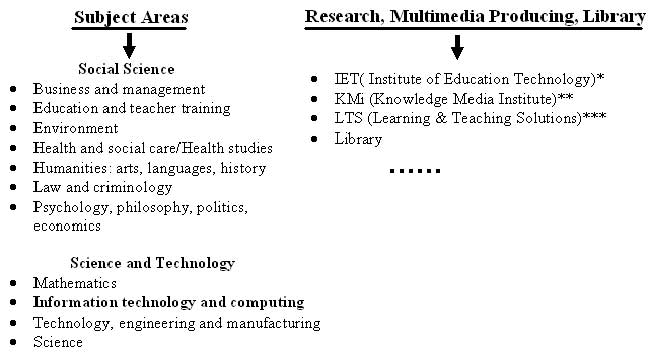
Figure-A
Note:
* IET (Institute of Education Technology) and its mainly researching areas are:
• Developing expertise in teaching and learning, especially as regards on-line and distance education
• Conducting fundamental research in teaching and e-learning
• Carrying out applied research in the use of new "hard" and "soft" technologies,
Examines, analyses; evaluates and influences on OU teaching and learning practices
• Supporting the educational professional development at the OU.
The IET takes many key functions in the academic activities of the OU. For example, if a new course is to be designed or an existed course is to be evaluated, some good fundamental questions and research works from the IET will be presented to the course designers:
Who are the students? And the related key questions are:
a. What is the students' level when they start?
b. What is the length of your courses?
c. How many key points (knowledge) you will present to the students?
d. At the end of a course, what do you want the students to know?
• **KMi (Knowledge Media Institute), established in 1995, its mainly researching areas are:
• Research and development in a convergence of areas;
• Cognitive and Learning Sciences;
• Artificial Intelligence;
• Semantic Technologies, and Multimedia etc.
In the following report, section 3, an example of its research project will be shown.
***LTS (Learning & Teaching Solutions) ---------design and produce the printed textbooks and multimedia teaching materials, including CD-ROMs, DVDs, and Audios etc.
The above excellent academic organization guarantees the success of the OU in the fields of teaching, research and development.
2. What is the teaching, and supporting system of the OU?
The system is shown as the following Figure-B.

Figure-B
The above teaching and supporting system clearly shows that a student of the OU is supported by many kinds of teaching multimedia and practical helps both by e-learning ways of on line and by face-to-face teaching. Especially, its feedback and evaluation systems are in a high academic level, providing much crucial information and many suggestions to the relevant course teams and administrators to boost the teaching qualities.
3. What is the R&D of the OU? ---- An example of "Magpie"
Research is the central mission of the Open University. It has established research area excellent in many academic fields. An important mission of the OU is to establish the link between the teaching materials and its up-to-date research outcomes.
The following example, named "Magpie", shows one of the R&D projects of KMi to arouse my Chinese colleague's interests of the field.
"Magpie" is a new kind of semantic filter (tool) developed by the staffs of KMi, aiming to identify and filter out the concepts-of-interest from any web page. It extremely suits for students' on-line studies. With this new kind of e-leaning tool, the distance study materials will be given a kind of dynamic links of the concepts and relations by the knowledge model.
The following Figure-C shows how the "Magpie" works in a very practical way and it is easy to be understood. After the software is installed, newly added functions are shown in different colours in the website you opened. In our case, the Green represents for "Person", who is related to this website article. the Red for "Project", the Blue for "Research-Area" etc. Suppose, you are just studying a textbook, in the book, you want to follow up the meaning of the technical term "Magpie" of the software. In this case, the term "Magpie" is in Red colour, meaning a "Project"---- the first level of knowledge model, which links with "Magpie -Project Details". And also, the "Magpie -Project Research Areas", the "Magpie -Resulting Technologies" etc (Figure-C1) will be shown as the second level of knowledge model, providing more detail information about "Magpie" if you continue to open the web page.
It's clear that the system sorts the interested knowledge out from a course, links with both the textbook contents and the up-date information of the knowledge through website together. This tool is very practical, useful and helpful e-learning approach both for students finish their academic works efficiently and expand their practical knowledge. It's worthy for our OUC colleagues to further study.
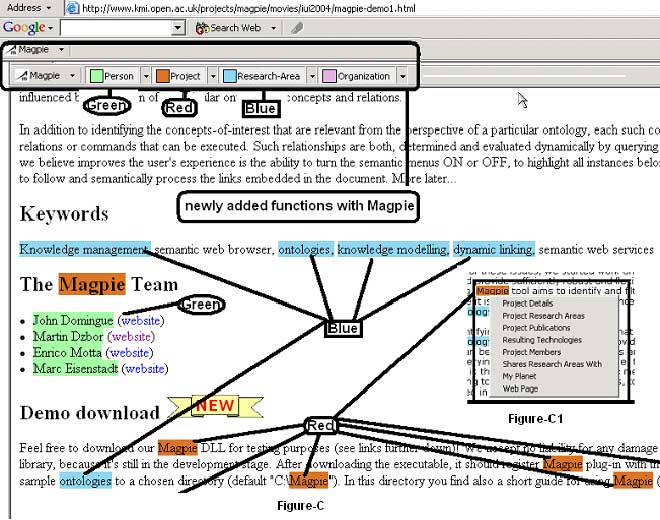
4. What is the organization of Qualifications and Courses of the OU? A typical example ----the Qualification of Information Technology
The following content deals with my most interested academic area---- the Qualifications of Information technology. In this area, we (OUC and OU) have many similarities and also have different features.
The qualifications (degree, certificate or diploma) of the OU are made of a group of appropriate courses, which is organized together to form a specific qualification levels, shown as Figure-D.

Figure-D
Further more, we decode a qualification of Degrees----- "BSc (Hons) Information and Communication Technologies Code: B38", which is the most related my teaching area.
From the website of the OU, much clear and helpful information of the degree will be given to a "Student" as following:
- Requirement: 360 points, Level: Undergraduate;
- Registration information;
- Description: the technical field description----dealing with hardware- or system-based aspects of information and communication technologies;
- Planning studies: how to get start and the what is the flexibility for choosing courses;
- Career relevance of linking the qualification with career.
1. Professional recognition from the Institution of Incorporated Engineers (IIE) or the Institution of Electrical Engineers (IEE).
2. Careers website at www.open.ac.uk/careers
- Courses: the organization of courses as the following described.
Course -Level 1
- Networked Living: Exploring Information and Communication Technologies,Points: 30, Code: T175
- Data, Computing and Information, Points: 30, Code: M150
- Open Mathematics, Points: 30, MU120 (or course 4)
- Using Mathematics, Points: 30,MST121 (or course 3)
Course -Level 2
- Information and Communication Technologies: People and Interactions, Points: 60, Code: T209
- Computers and Processors, Points: 30, Code: T224
Course -Level 3
- Digital Communications, Points: 60, Code: T305
- Artificial Intelligence for Technology, Points: 30, Code: T396
- The T305 project, Points: 30, Code: TM423 (or course 10)
- The T396 Project, Points: 30, Code: TM426 (or course 9)
Additional 60 points can be taken from any OU courses.
From the above description, we can taste the unique feature of course design and the flexibility of course choosing policy at the OU.
5. What is the course's design feature of the OU? ----Two illustrating examples
What's the feature of a typical textbook in science and technology fields of the OU? How is the knowledge of the textbook to be organized? Example 1 will illustrate a typical course feature of the OU; and example 2 will give our Chinese colleagues a general and succinct concept about the multimedia design in a course.
Example-1:
A course Data, Computing and Information, Points: 30, Code: M150
Each course at the OU has a set of aims and objects, which are used by course authors in their writing and by the students in their studying.
This course aims to:
- Explain why people use computer;
- Demonstrate that the process of using computer begins with human; perceptions and is prompted by our curiosity about the world, and our need to control parts of it;
- Help the students make more effective use of their computer;
- Teach the students how to program;
- Provide the students with study skill, such as information finding, and transferable skill, …
- …
The example here shows a data processing example about how to capture data from sound, sight and touch, which surrounded us; how to master the practical computer skill to transform the acquired data into a meaningful code---Database; and finally, how to program and process the data into further information knowledge.
In the following Figure-E, it shows how to introduce the taught knowledge step-by-step, deeper and deeper in the textbook.
Figure-E1 shows that the textbook was made into CDs, the e-learning materials with file format of the "Adobe Acrobat".
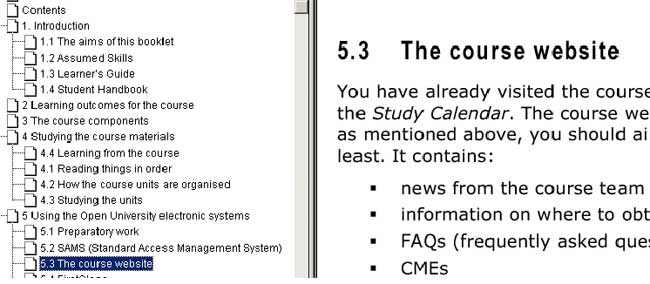
Figure-E1
Figure-E2 shows a railway map, by which the course will develop the procedure of transforming "those things" of daily life to the data and information. The course starts with a real and practical daily used map, which has two important meanings: The material used here is not virtual, and this will arouse more interests for a student to study and much easier to be understand; and also, starting from here, the course will present practical skill to a student about how to deal with the practical system. I wish our colleagues of the OUC to be enlightened by the course design model.

Figure-E2
Figure-E3 shows how to introduce the concept "data", as the meaningful code, which will be further used as database by computer software.

Figure-E3
Figure-E4 shows that the collected data was processed into a database, a kind of information to be used by computer software.
Figure-E5 shows that the database also can be used in a real product of the "GPS" for guiding drivers, in a way of linking the taught knowledge with practical product.
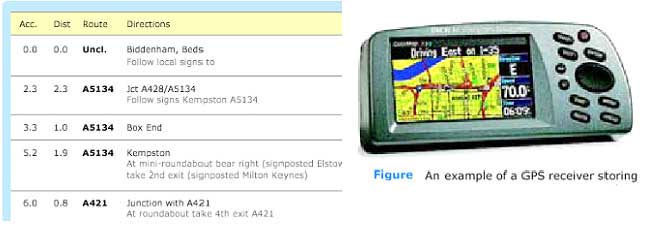
Figure-E4 Figure-E5
Example-2:
A typical course's organization and its multimedia design.
In the following Figure-F, it shows the organization of the course (code M150) and its multimedia design used for some another course.
Figure-F1 shows example of introducing a new concept "The Date object type" for programming with Java. Its feature is clear: to describe the concept succinctly and to give highlights to the important concepts.

Figure-F1
Figure-F2 shows how to introduce the knowledge of "the date structure" for further programming.
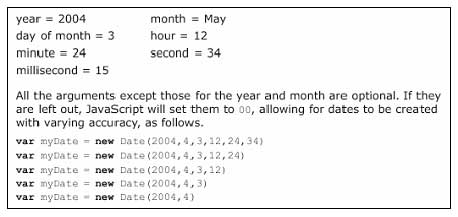
Figure-F2
Figure-F3 shows a "Self Assessment Question" arrangement just follows the newly studied knowledge, for a student to make an evaluation by one's self.
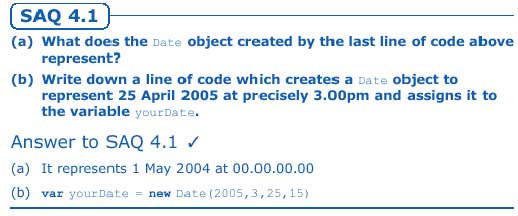
Figure-F3
Figure-F4 shows that the "Exercises" and "Discussion" is used to deepen the taught knowledge.
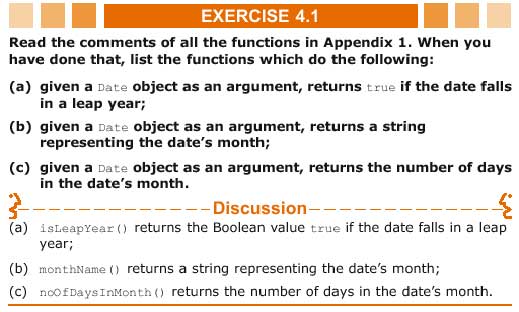
Figure-F4
Figure-F5 shows that step-by-step, the "Activity" is assigned to teach a student how to make a practical program.

Figure-F5
Finally, the Figure-F6 shows that a meaningful result will be arrived by the study. At this stage, a student will feel very successful in his efforts.

Figure-F6
From the above shown, we will have a taste of a typical course feature of the OU. That is the elaborate design linking taught contents with practical knowledge.
In distance teaching, a course is generally organized by multimedia, mainly including the printed textbooks and the video or audio teaching programmes. Many computer- made programmes, including animations, are widely presented in the CDs, acting as the role of auxiliary teaching materials. Generally speaking, at the OU, the multimedia includes audio or video teaching programmes (Figure-J1, Figure-J2) animations (Figure-J3) and self-assessment questions (Figure-J4).
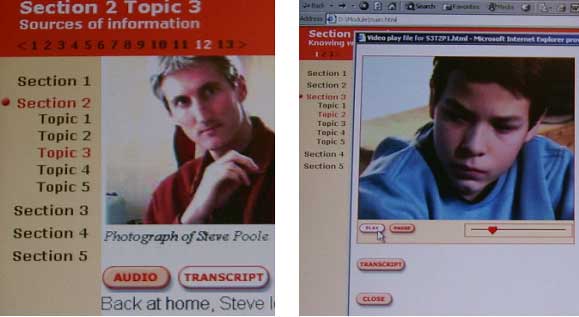
Figure-J1 Figure-J2

Figure-J3 Figure-J4
I have shared lots of helpful experiences about the course design.
6. Important personal academic activities at the OU
During my visit to the OU, I visited many academic departments, the Regional School and the Summer School of the OU. I attended many academic activities such as "the Open Day" of the OU, "the CALRG Conference 2005-Computer and Learning Research Group 26th Annual Conference" etc. From these activities, I learned and shared many precious and helpful experiences in academic fields.
However, the most important experience is the activity of interviewing academics of the OU. From those interviews and meetings, I grasped many essentials about course designs, multimedia productions, teaching support systems and research works at the OU. Some important ones are list as the following. In some cases, I discussed with them several times on the areas we were both interested in.
- Dr. Hossein Zand presented us lectures on the theory of distance education, aspects of teaching M, S, T at the OU and about the "Use of technology in course designs".
- Mrs. Yu Yunxiu, the President of the OUC
- Professor Christopher Bissell, the dean of Information and Communication, about course organizations and contents, technical skills, software used in the course and multimedia cooperation.
- Dr. Philip Butcher, the expert of the course designs, about the use of multimedia in course designs.
- Ms Anne Howell, the director of Learning and Teaching Solution, about course designs and multimedia production.
- Mr. Carol Morris, the sub-dean of Technology, about teaching, learning, course designs and students in technical areas.
- Dr Jim Iley, the sub-dean of Science, about teaching, learning, course designs and students in science fields.
- Ms Bemie Clark, lecture of Technology, about the qualification of Information and Communication and the course of Computers and Processors, the course of Logic Design and computer software for Electronic Automation Design.
- Mr Richard Seaton, lecture of Technology, about the qualification of Information and Communication and the course of "Computers and Processors".
- Mr. Zhu Jian-Han, the research fellow of the KMi, about R&D
- Mr Gordon Burt, the senior lecture of the Institute of Education Technology, about research work on evaluation
- Mr R.Goodfellow, the senior lecture of the Institute of Education Technology, about e-leaning.
- Mr M.U. Hassan, the staff of the Institute of Education Technology, about teaching and learning support system and the feedback systems.